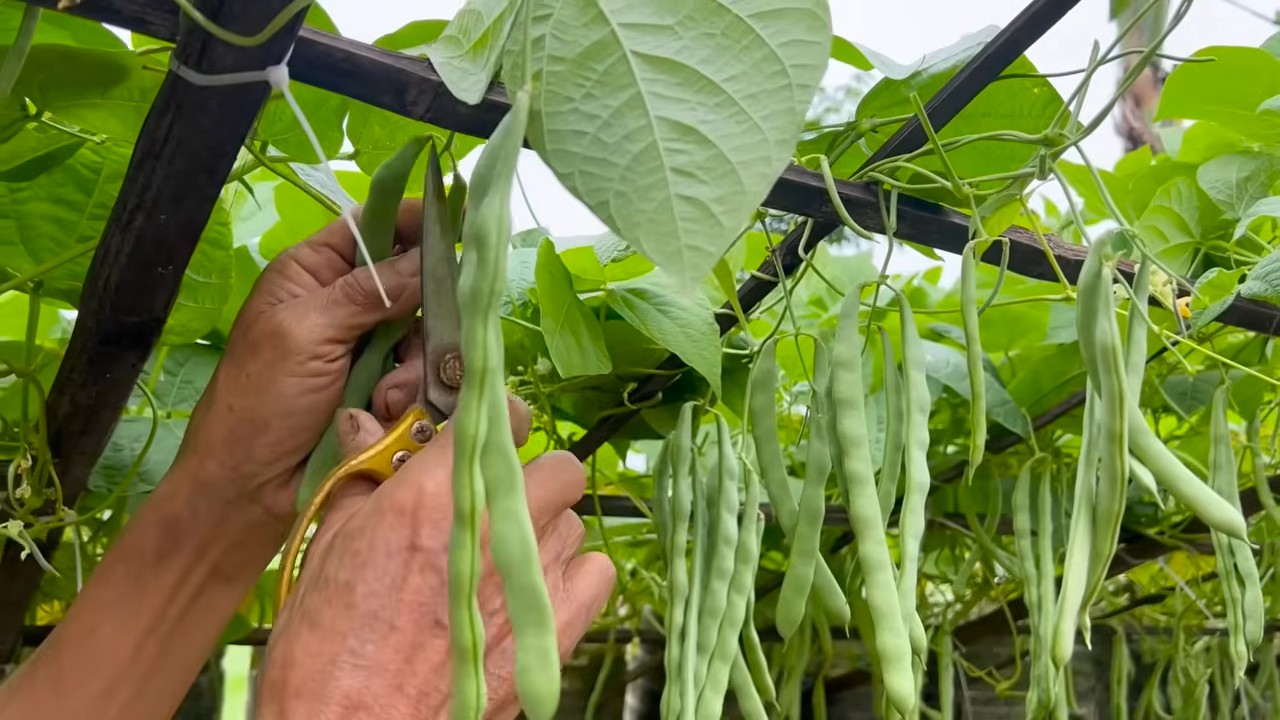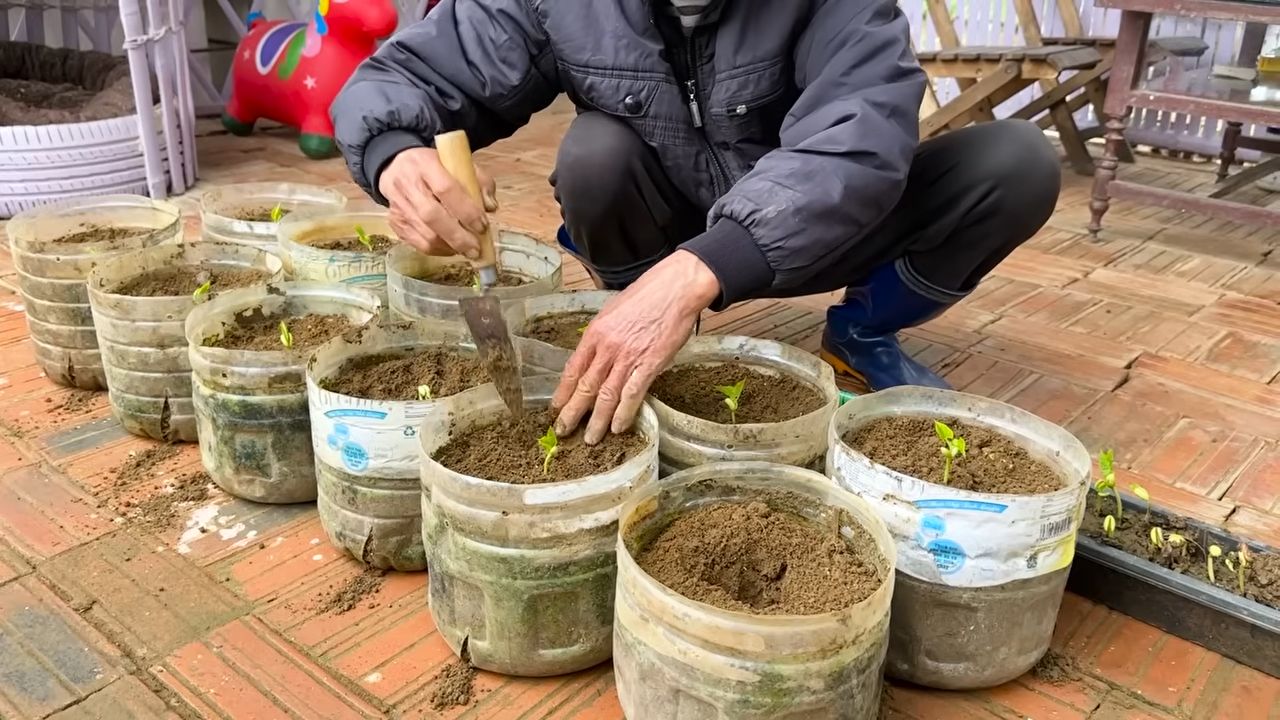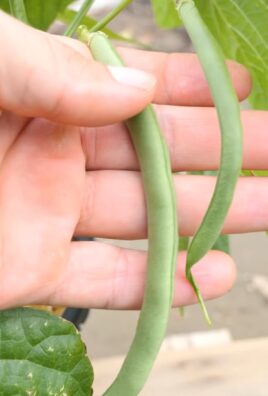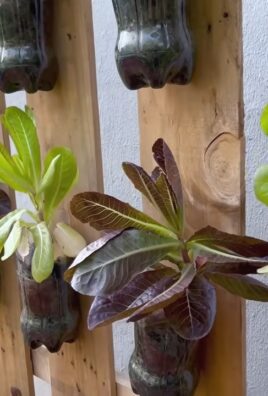Growing bean plants can seem daunting, especially if you’re new to home gardening. But trust me, with a few clever tricks and a little DIY spirit, you can be harvesting your own delicious beans in no time! Forget those bland, store-bought beans – imagine the satisfaction of plucking fresh, vibrant green beans straight from your backyard, knowing you nurtured them from tiny seeds.
Beans have a rich history, dating back thousands of years and playing a vital role in diets across the globe. From ancient civilizations in the Americas to traditional European cuisine, beans have been a staple food source, providing essential nutrients and sustenance. Think of the classic Three Sisters planting method used by Native American tribes, where beans, corn, and squash thrived together in a symbiotic relationship – a testament to the power and versatility of these humble legumes.
So, why do you need these DIY tricks for growing bean plants? Well, let’s face it, gardening can be unpredictable. Pests, diseases, and even just the wrong soil conditions can derail your efforts. But with these simple hacks, I’ll show you how to overcome common challenges, maximize your yield, and enjoy a bountiful harvest. I’m excited to share my favorite tips and tricks that will make growing bean plants a breeze, even if you have limited space or experience. Let’s get started!

Bohnen selbst anbauen: Ein umfassender DIY-Leitfaden
Hallo Gartenfreunde! Ich freue mich riesig, euch heute in die wunderbare Welt des Bohnenanbaus einzuführen. Bohnen sind nicht nur super lecker und gesund, sondern auch relativ einfach anzubauen, selbst wenn ihr noch Gartenneulinge seid. In diesem Artikel zeige ich euch Schritt für Schritt, wie ihr eure eigenen Bohnen erfolgreich anpflanzen und ernten könnt. Los geht’s!
Warum Bohnen selbst anbauen?
Bevor wir ins Detail gehen, lasst mich kurz erklären, warum ich so begeistert vom Bohnenanbau bin:
* Frische und Geschmack: Selbst angebaute Bohnen schmecken einfach unvergleichlich besser als die aus dem Supermarkt. Der Unterschied ist wirklich enorm!
* Nachhaltigkeit: Ihr wisst genau, was in euren Garten kommt und könnt Pestizide vermeiden. Das ist gut für euch und die Umwelt.
* Kostengünstig: Einmal in Saatgut investiert, könnt ihr eine reiche Ernte einfahren und so Geld sparen.
* Bodenverbesserung: Bohnen sind Leguminosen, das heißt, sie reichern den Boden mit Stickstoff an. Das ist super für eure anderen Pflanzen!
* Vielfalt: Es gibt unzählige Bohnensorten, von Buschbohnen über Stangenbohnen bis hin zu Feuerbohnen. Da ist für jeden Geschmack etwas dabei.
Die richtige Bohnensorte auswählen
Die Wahl der richtigen Bohnensorte ist entscheidend für euren Erfolg. Hier ein paar beliebte Optionen:
* Buschbohnen: Diese Bohnen wachsen kompakt und benötigen keine Rankhilfe. Sie sind ideal für kleinere Gärten oder den Anbau in Töpfen. Beliebte Sorten sind ‘Provider’, ‘Goldmarie’ und ‘Rocdor’.
* Stangenbohnen: Stangenbohnen wachsen in die Höhe und benötigen eine Rankhilfe, wie z.B. ein Rankgitter oder Stangen. Sie sind sehr ertragreich und nehmen wenig Platz am Boden ein. Beliebte Sorten sind ‘Blauhilde’, ‘Neckarkönigin’ und ‘Preisgewinner’.
* Feuerbohnen: Feuerbohnen sind nicht nur lecker, sondern auch wunderschön anzusehen. Sie haben auffällige rote Blüten und benötigen ebenfalls eine Rankhilfe. Beliebte Sorten sind ‘Preisprunk’ und ‘Scarlet Runner’.
* Trockenbohnen: Diese Bohnen werden nicht als grüne Bohnen geerntet, sondern getrocknet und gelagert. Sie sind ideal für die Vorratshaltung. Beliebte Sorten sind ‘Borlotti’ und ‘Pinto’.
Überlegt euch, welche Bohnen ihr am liebsten esst und wie viel Platz ihr zur Verfügung habt, bevor ihr euch für eine Sorte entscheidet.
Der richtige Zeitpunkt für die Aussaat
Bohnen sind frostempfindlich und sollten erst nach den Eisheiligen (Mitte Mai) ausgesät werden. Der Boden sollte sich bereits etwas erwärmt haben. Ich warte meistens bis Ende Mai oder Anfang Juni, um auf Nummer sicher zu gehen.
* Vorziehen: Ihr könnt Bohnen auch im Haus vorziehen, um den Erntezeitpunkt etwas vorzuverlegen. Säät die Bohnen etwa 2-3 Wochen vor dem geplanten Auspflanztermin in kleine Töpfe.
* Direktsaat: Die Direktsaat ist die einfachste Methode. Säät die Bohnen direkt ins Beet.
Schritt-für-Schritt-Anleitung: Bohnen anbauen
Hier kommt nun die detaillierte Anleitung, wie ihr eure eigenen Bohnen erfolgreich anbauen könnt:
1. Vorbereitung des Bodens
Ein guter Boden ist das A und O für eine reiche Ernte.
1. Boden lockern: Lockert den Boden gründlich auf, am besten mit einer Grabegabel oder einem Spaten. Entfernt dabei Unkraut und Steine.
2. Kompost einarbeiten: Mischt reichlich Kompost unter den Boden. Kompost versorgt die Bohnen mit wichtigen Nährstoffen und verbessert die Bodenstruktur.
3. Boden ebnen: Ebnet den Boden mit einem Rechen, sodass eine gleichmäßige Oberfläche entsteht.
2. Aussaat der Bohnen
Jetzt geht es ans Eingemachte!
1. Reihen ziehen: Zieht mit einem Rechen oder einer Hacke Reihen in den Boden. Der Abstand zwischen den Reihen sollte je nach Bohnensorte variieren. Bei Buschbohnen reichen 40-50 cm, bei Stangenbohnen sollten es 60-80 cm sein.
2. Saattiefe: Die Saattiefe beträgt etwa 3-5 cm.
3. Bohnen säen: Legt die Bohnen in die Reihen. Der Abstand zwischen den Bohnen sollte bei Buschbohnen etwa 5-10 cm betragen, bei Stangenbohnen etwa 10-15 cm.
4. Bedecken: Bedeckt die Bohnen mit Erde und drückt sie leicht an.
5. Gießen: Gießt die Reihen vorsichtig an, damit die Erde nicht weggespült wird.
3. Pflege der Bohnenpflanzen
Nach der Aussaat ist es wichtig, die Bohnenpflanzen gut zu pflegen.
1. Gießen: Gießt die Bohnen regelmäßig, besonders während der Blütezeit und der Hülsenbildung. Achtet darauf, dass der Boden nicht austrocknet, aber auch nicht zu nass ist.
2. Unkraut jäten: Entfernt regelmäßig Unkraut, damit die Bohnenpflanzen nicht von Unkraut überwuchert werden.
3. Anhügeln: Wenn die Bohnenpflanzen etwa 15-20 cm hoch sind, könnt ihr sie leicht anhäufeln. Das gibt ihnen zusätzlichen Halt und fördert die Wurzelbildung.
4. Rankhilfe anbringen (bei Stangenbohnen): Sobald die Stangenbohnen anfangen zu ranken, benötigen sie eine Rankhilfe. Ihr könnt ein Rankgitter, Stangen oder ein Seil verwenden. Achtet darauf, dass die Rankhilfe stabil ist und den Bohnenpflanzen genügend Halt bietet.
5. Düngen: Bohnen benötigen nicht viel Dünger. Eine leichte Düngung mit Kompost oder organischem Dünger während der Blütezeit kann jedoch nicht schaden. Vermeidet stickstoffhaltige Dünger, da diese das Wachstum der Blätter fördern, aber die Hülsenbildung hemmen können.
4. Schutz vor Schädlingen und Krankheiten
Auch Bohnen können von Schädlingen und Krankheiten befallen werden. Hier ein paar Tipps, wie ihr eure Bohnen schützen könnt:
* Bohnenfliege: Die Bohnenfliege kann die Keimlinge befallen und zum Absterben bringen. Schützt die Keimlinge mit einem Vlies oder einer Folie.
* Blattläuse: Blattläuse saugen an den Blättern und können die Bohnenpflanzen schwächen. Bekämpft Blattläuse mit einem Wasserstrahl oder mit Nützlingen wie Marienkäfern.
* Bohnenrost: Bohnenrost ist eine Pilzkrankheit, die sich durch braune Flecken auf den Blättern äußert. Entfernt befallene Blätter und sorgt für eine gute Belüftung der Pflanzen.
* Schnecken: Schnecken lieben junge Bohnenpflanzen. Schützt eure Pflanzen mit Schneckenkorn oder Schneckenzäunen.
5. Ernte der Bohnen
Endlich ist es soweit! Die Bohnen sind reif und können geerntet werden.
1. Erntezeitpunkt: Der Erntezeitpunkt hängt von der Bohnensorte ab. Grüne Bohnen sind reif, wenn die Hülsen prall gefüllt sind und sich leicht brechen lassen. Trockenbohnen werden geerntet, wenn die Hülsen trocken und braun sind.
2. Erntemethode: Pflückt die Bohnen vorsichtig von der Pflanze ab. Achtet darauf, die Pflanze nicht zu beschädigen.
3. Regelmäßige Ernte: Erntet die Bohnen regelmäßig, damit die Pflanze weiterhin neue Hülsen bildet.
Zusätzliche Tipps und Tricks
Hier noch ein paar zusätzliche Tipps, die euch beim Bohnenanbau helfen können:
* Fruchtfolge beachten: Baut Bohnen nicht jedes Jahr am selben Standort an. Wechselt die Anbaufläche, um Krankheiten und Schädlingen vorzubeugen.
* Mischkultur

Conclusion
So, there you have it! Growing bean plants from the comfort of your own home is not only achievable but also incredibly rewarding. We’ve walked through the simple steps, from selecting the right bean variety to nurturing your seedlings and eventually harvesting a bounty of fresh, delicious beans. But why is this DIY trick a must-try?
Firstly, the taste. There’s simply no comparison between store-bought beans and those you’ve lovingly grown yourself. The flavor is fresher, more vibrant, and bursting with natural goodness. Imagine the satisfaction of serving a meal featuring beans you cultivated from seed to table – a true testament to your gardening prowess.
Secondly, the cost savings. While the initial investment in seeds and perhaps some basic gardening supplies is required, you’ll quickly recoup those costs as your bean plants flourish and provide you with a continuous supply of fresh produce. Think of all the money you’ll save on grocery bills, not to mention the reduced environmental impact of not purchasing commercially grown beans that have been transported long distances.
Thirdly, the sheer joy of gardening. There’s something inherently therapeutic about getting your hands dirty, nurturing a plant, and watching it grow. Growing bean plants offers a tangible connection to nature, a sense of accomplishment, and a welcome respite from the stresses of daily life. It’s a hobby that can be enjoyed by people of all ages and skill levels.
But the fun doesn’t stop there! Feel free to experiment with different bean varieties. Try growing bush beans for a compact, space-saving option, or pole beans that climb trellises and add vertical interest to your garden. Explore heirloom varieties for unique flavors and colors. You can even try succession planting, sowing new seeds every few weeks to ensure a continuous harvest throughout the growing season.
Consider companion planting to enhance the growth and flavor of your bean plants. Plant them alongside herbs like rosemary or thyme to deter pests, or with vegetables like carrots or cucumbers to create a mutually beneficial relationship.
And don’t forget about the flowers! Bean plants produce beautiful blossoms that attract pollinators like bees and butterflies, adding a touch of beauty to your garden.
Ultimately, growing bean plants is a simple, affordable, and incredibly rewarding DIY project that offers a multitude of benefits. It’s a chance to connect with nature, save money, enjoy fresh, delicious produce, and experience the satisfaction of growing your own food.
So, what are you waiting for? Grab some bean seeds, prepare your soil, and get ready to embark on a gardening adventure. We encourage you to try this DIY trick and share your experiences with us. Post photos of your bean plants on social media using #HomeGrownBeans and tell us about your favorite bean varieties and gardening tips. We can’t wait to see what you create! Let’s cultivate a community of bean-growing enthusiasts and inspire others to discover the joys of homegrown goodness. Happy gardening!
Frequently Asked Questions (FAQ)
What kind of soil is best for growing bean plants?
Bean plants thrive in well-drained soil that is rich in organic matter. A slightly acidic to neutral pH (around 6.0 to 7.0) is ideal. Before planting, amend your soil with compost or well-rotted manure to improve its fertility and drainage. Avoid heavy clay soils, as they can become waterlogged and hinder root development. If you have clay soil, consider growing your beans in raised beds or containers with a suitable potting mix.
How often should I water my bean plants?
Water your bean plants regularly, especially during dry periods. Aim to keep the soil consistently moist but not waterlogged. Water deeply at the base of the plants, avoiding wetting the foliage, which can increase the risk of fungal diseases. A good rule of thumb is to water when the top inch of soil feels dry to the touch. Mulching around the plants can help retain moisture and suppress weeds. During hot weather, you may need to water more frequently.
What are some common pests and diseases that affect bean plants, and how can I prevent them?
Bean plants can be susceptible to various pests and diseases, including aphids, bean beetles, spider mites, and fungal diseases like powdery mildew and bean rust. To prevent these problems, practice good garden hygiene. Remove any dead or diseased plant material promptly. Ensure good air circulation around your plants by spacing them properly. Inspect your plants regularly for signs of pests or diseases and take action promptly. You can use organic pest control methods like insecticidal soap or neem oil to control aphids and other pests. For fungal diseases, consider using a copper-based fungicide. Crop rotation can also help prevent soilborne diseases.
How long does it take for bean plants to produce beans?
The time it takes for bean plants to produce beans varies depending on the variety and growing conditions. Generally, bush beans mature in about 50 to 60 days, while pole beans take about 60 to 75 days. You can start harvesting beans when they are young and tender. Regular harvesting encourages the plants to produce more beans.
Can I grow bean plants in containers?
Yes, you can successfully grow bean plants in containers, especially bush bean varieties. Choose a container that is at least 12 inches deep and wide to provide adequate space for the roots. Use a well-draining potting mix and ensure the container has drainage holes. Place the container in a sunny location and water regularly. Pole beans can also be grown in containers, but they will require a trellis or other support structure to climb on.
What are some good companion plants for bean plants?
Bean plants benefit from companion planting with various other plants. Some good companions include:
* **Marigolds:** Repel bean beetles and other pests.
* **Rosemary and Thyme:** Deter bean beetles.
* **Carrots:** Improve soil structure and deter bean flies.
* **Cucumbers:** Provide shade and support for bean plants.
* **Corn:** Provides support for pole beans (the “Three Sisters” method).
* **Potatoes:** Help to deter bean beetles.
Avoid planting bean plants near onions or garlic, as they can inhibit bean growth.
How do I know when my beans are ready to harvest?
Beans are typically ready to harvest when the pods are firm, plump, and easily snap off the plant. The beans inside the pods should be well-developed but not overly mature. Overripe beans can be tough and stringy. Harvest beans regularly to encourage continued production.
Can I save bean seeds for planting next year?
Yes, you can save bean seeds for planting next year. Allow some of your bean pods to dry completely on the plant. Once the pods are dry and brittle, shell the beans and store them in an airtight container in a cool, dry place. Label the container with the bean variety and date. Before planting, test the germination rate of your saved seeds by planting a few in a pot and observing how many sprout.
My bean plants are flowering, but not producing beans. What could be the problem?
There are several reasons why your bean plants might be flowering but not producing beans:
* **Lack of Pollination:** Bean flowers are typically self-pollinating, but sometimes they may require assistance from pollinators like bees. If you are not seeing many bees in your garden, you can try hand-pollinating the flowers by gently shaking the plants or using a small brush to transfer pollen from one flower to another.
* **High Temperatures:** High temperatures can interfere with pollination and bean development. If the weather is consistently hot, try providing some shade for your bean plants during the hottest part of the day.
* **Nutrient Deficiency:** A lack of essential nutrients, such as phosphorus or potassium, can also affect bean production. Amend your soil with a balanced fertilizer or bone meal to provide these nutrients.
* **Water Stress:** Both overwatering and underwatering can stress bean plants and reduce bean production. Ensure that your plants are receiving consistent moisture but are not waterlogged.
* **Variety:** Some bean varieties are simply less productive than others. If you are not satisfied with the yield of your current variety, consider trying a different one next year.
Is it better to start bean plants indoors or sow them directly in the garden?
Bean plants are generally easy to grow from seed directly in the garden. They do not transplant well, so starting them indoors is not typically recommended. However, if you live in an area with a short growing season, you can start bean plants indoors a few weeks before the last expected frost. Use biodegradable pots to minimize root disturbance when transplanting. Make sure the soil is warm enough before transplanting.




Leave a Comment